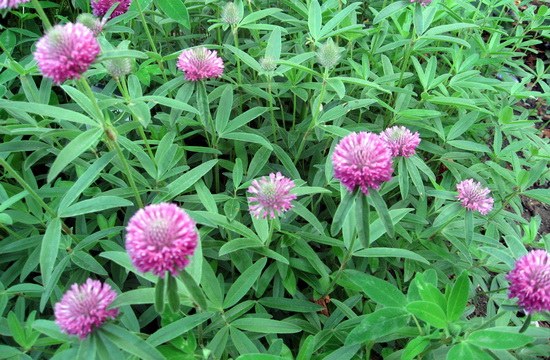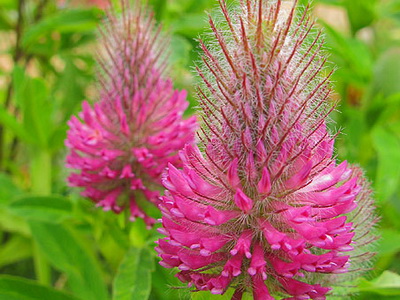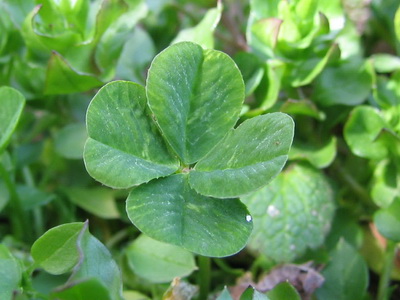
Clover (Trifolium) is a genus of annual and perennial herbs of the legume family (Fabaceae) of the moth subfamily (Faboideae), growing in the temperate zone of Europe, Asia, North and South America, in the north of the African continent and in Australia. Many species are valuable fodder crops, some are grown as ornamental plants .
- Family: legumes.
- Origin: Mediterranean.
- Rhizome: the root system is pivotal, deeply penetrating.
- Stem: hollow, branching.
- Leaves: mostly trifoliate, rarely pinnate or four-leaved.
- Fruit: bean.
- Reproductive ability: propagated mainly by seeds, some species also by division and rooting of shoots.
- Illumination: Relatively shade-tolerant.
- Watering: plentiful without waterlogging.
- Content temperature: frost-resistant.
- Flowering time: May-September.
flower clover green
Representatives of the genus are perennial , rarely annual herbaceous plants with cylindrical, hollow stems inside, erect or ascending, in some species creeping, often knotty, branching. The shape of the leaf, usually consisting of three plates, is a characteristic feature of the genus, which is reflected in its Latin name: “trifolium” means “shamrock” in translation. Individual leaf blades may be obovate, oblong oval, oblong or narrow, with a simple or serrated margin. The leaves of all species are petiolate, thin and delicate, with membranous stipules, painted in dark or light green, gray-bluish or purple, some decorative forms have contrasting spots and blotches on the leaf plates.
The root system is well developed, with cylindrical or fusiform taproots, in some species with a woody rhizome. The main root is able to penetrate into deep (up to 2 m or more) soil layers, however, the bulk of the roots is located close to the surface, not falling below 40-50 cm.
Like all legumes, the culture has nitrogen-fixing properties, on its roots there are numerous colonies of nodule bacteria that can retain atmospheric nitrogen and process it into a form available to plants. Thanks to this feature, where clover grows, the soil is enriched with nitrogen, which makes it possible to use it as green manure.

The flowers are small, sessile, white, pink or yellow, usually form apical capitate inflorescences, which in turn are collected in racemes, panicles, rarely arranged singly.
A separate flower has a five-petaled moth-type corolla with the so-called “sail” or “flag” (upper large petal), “wings” (two side petals) and “boat” (two lower, often completely or partially fused petals). Of the ten stamens available, usually nine grow together, one remains free, but in some species all stamens can be fused, or, conversely, free. The short ovary contains 2-6 ovules. The fruit, a leathery bean with one, two, less often three or six seeds, opens late, and sometimes does not open at all. In some species, the fetus breaks into segments. Seeds are small, spherical or elongated.
The plant is widespread in the temperate zone of all continents, grows in meadows, fields, forests and along roads, thanks to a powerful tap root system, many species develop well in arid and mountainous areas. Due to the structural features of the clover flower, the only insects capable of pollinating it are bumblebees and bees, which significantly affects the area where the culture grows.
Where does clover grow?
The first description of clover is found in the writings of a man who lived in the 4th century BC. ancient Greek philosopher and naturalist Theophastus. Already in antiquity, the plant was considered one of the best forage grasses, as evidenced by the works of ancient Roman authors, in particular, Cato the Elder (2nd century BC). In the Middle Ages in Europe, the plant was already grown for the production of feed, but in Russia its cultivation began a little later. Only in 1819 the seeds of hybrid clover were brought by I.I. Samarin, a small landowner from the Yaroslavl province, after which it began to be cultivated throughout the country.
Interestingly, the importance of clover in human history is not limited to its agricultural value. Even the ancient Druids, who lived on the lands of Western Europe, considered the plant magical, its trifoliate leaves symbolized fertility, abundance and rebirth, were used as amulets of eternal youth. The four-leaf clover was especially revered, a special mutation of the culture, which is quite rare in nature. In pagan culture, a leaf with four lobes was considered a symbol of the four natural elements, earth, water, fire and air. People believed that the lucky one who found it would always be lucky. Centuries passed, cultures changed, but the belief in the magical properties of clover remained. During the Middle Ages, the three-leafed clover already embodies the idea of the Holy Trinity – God the Father, God the Son and God the Holy Spirit. It is believed that for the first time a stem with a flower was used to explain the sacrament of the Holy Trinity by the patron saint of Ireland, St. Patrick, while with a shamrock he expelled all snakes from the settlements. Since then, green clover has been considered a symbol of Ireland, its leaf has been included in the small coat of arms of this country and is depicted on its flag. As for the four-leaf clover, in the Middle Ages, and even today, as before, as in antiquity, many are convinced that it brings incredible luck, not only to the finder, but to everyone who is close to him. In modern subculture, images of a four-leaf clover are used to make pendants, amulets, and amulets. There are firms specializing in the cultivation of special varieties with four-lobed leaves, which are in high demand and are used to make gifts, souvenirs, etc.
Useful properties of clover
Clover has been widely used in fodder production for a long time, due to the high protein content (up to 12-13%), hay and silage from it are close to concentrated fodder in terms of nutritional value. The property of clover to improve the structure of the soil and accumulate atmospheric nitrogen in it makes it a good predecessor for cereals, flax, vegetables, and allows the use of grass as a green fertilizer. Some species are considered valuable honey plants, their honey is of high quality, does not crystallize for a long time, has a white color, delicate, pleasant taste and aroma. 1 ha.
The beneficial properties of clover are well known in folk medicine. A complex chemical composition, including vitamins C, A, E, B1, B2, trace elements magnesium, potassium, calcium, iron, chromium, selenium, as well as a number of valuable flavonoids , organic acids and other biologically active substances, allows the plant to be used to reduce cholesterol and normalization of fat metabolism, strengthening the walls of blood vessels, as a vitamin remedy. Clover has a diuretic and antiseptic effect, which is why it is recommended for the treatment of the urinary tract. A good effect is exerted by rinsing with a decoction of herbs in the treatment of angina with folk remedies, ingestion as an expectorant and anti-inflammatory agent for coughing. Outwardly, decoctions and infusions treat burns and boils.
As an ornamental, the culture is less common, but there are several very attractive, long-flowering and unpretentious species and varieties of clover grown as ground cover and lawn plants. They are able to fill a significant area in a short time, so they need to contain and limit growth in the flower garden.
Common types and varieties of clover
In total, there are more than 300 species of clover, of which about 70 grow on the territory of the former USSR, up to 40 – in North America, in the Rocky Mountains. In Russia, a number of species are widely distributed as fodder crops on natural pastures, grown in field and fodder crop rotations in order to obtain hay, silage, seeds, and improve soil structure. Below are descriptions and photos of clovers, the most famous in our country, as well as some decorative varieties that are promising for floriculture.
Red clover or red clover
Red clover or red clover (T. pratens) is a biennial or perennial plant 15 – 55 cm high with branched ascending stems, delicate trifoliate leaves, often covered with whitish spots, and loose globular capitate inflorescences, red, sometimes white or multi-colored.

The grass contains a lot of protein, is not inferior in nutritional value to alfalfa, is grown as green fodder, for hay or silage. The green mass remaining after threshing the seeds is considered an excellent fertilizer. In Russia, it has been cultivated for 200 years, grown in spring and winter crops. Among the varieties of domestic breeding, the most famous are Moskovsky 1, Vyatsky, Yaroslavsky, Pskov, Chernigov, Srednerussky, Podolsky, etc.
Three-leafed clover and its photo
Creeping or white clover, (T. repens) is a perennial up to 40 cm high with creeping stems rooting in the internodes and trifoliate elliptical petiolate leaves, serrated along the edge, with whitish spots at the base. The flowers are small, white, pink or greenish, collected in apical rounded inflorescences, bloom from May until frost.

A very durable species compared to other clovers, its age can reach 10 years. It is characterized by exceptional resistance to trampling and the ability to recover quickly, which, combined with the high nutritional value of green mass, makes it one of the best pasture crops. Excellent honey plant.
Due to its durability and ability to grow rapidly, the plant can be used as a ground cover and lawn crop. Breeders have created several interesting varieties of creeping clover, photos and brief descriptions of some of the most famous are given below.
Dark Dancer is distinguished by bright leaves, burgundy, edged with green, and contrasting white flowers;

Dagon’s Blood has very light leaves with contrasting blood red spots,

Green Ice , with variegated leaves, one half of which is light green, the other is dark.

Four-leaf clover
There are several specially bred “happy” four-leaf cultivars:
Quadrifolium with green leaf blades;

Purpurascens Quadrifolium – with purple, bordered green, leaves;

Good Luck , variegated, green with a dark spot in the center.

clover pink
Pink clover, or hybrid (T. hybridium) is a perennial species whose natural habitat is Europe and the adjacent part of Asia. It has been cultivated everywhere since the 18th century, thanks to which it has become naturalized in nature in vast areas in Asia, North America, and northern Africa. It has ascending or straight stems 30-80 cm high, petiolate trifoliate leaves and spherical pink-white inflorescences, blooming from early summer to early autumn.

It is used as a fodder plant, although recently it has been supplanted by the more productive red clover. It has advantages over the latter when grown on wet and acidic soils, where it gives higher yields. A highly productive honey plant, due to short, up to 3 mm, tubes of the corollas of flowers, their nectar is available for pollination by all types of bees. Unlike red clover, the leaves of this species are rather firmly attached to the petioles and do not fall off during harvesting, which makes the hay softer, however, due to the bitter taste, it is worse eaten by livestock and is usually used mixed with cereals.







